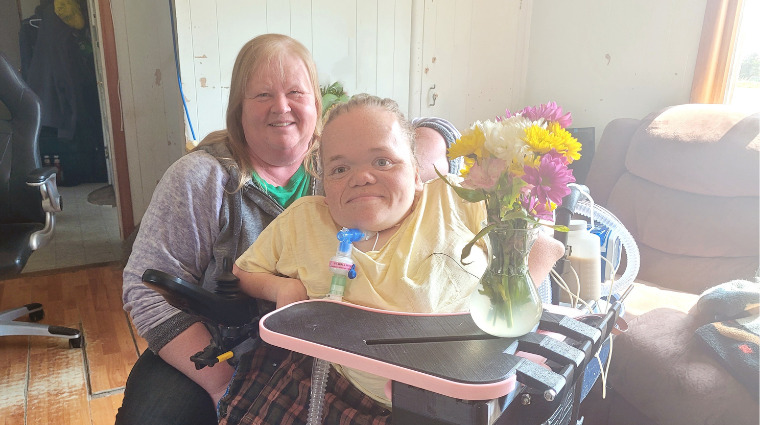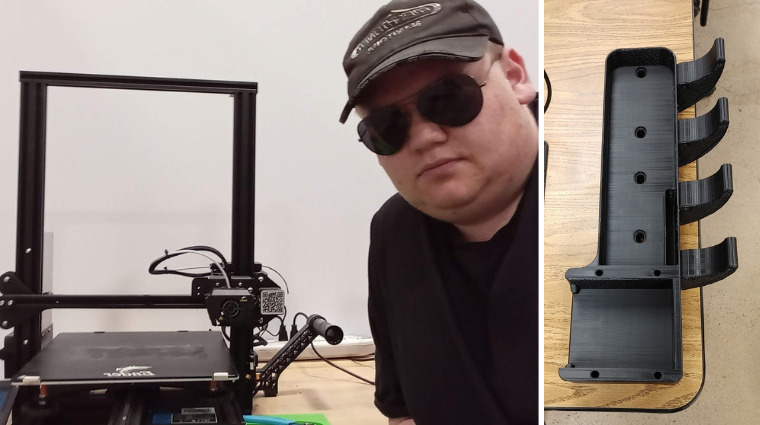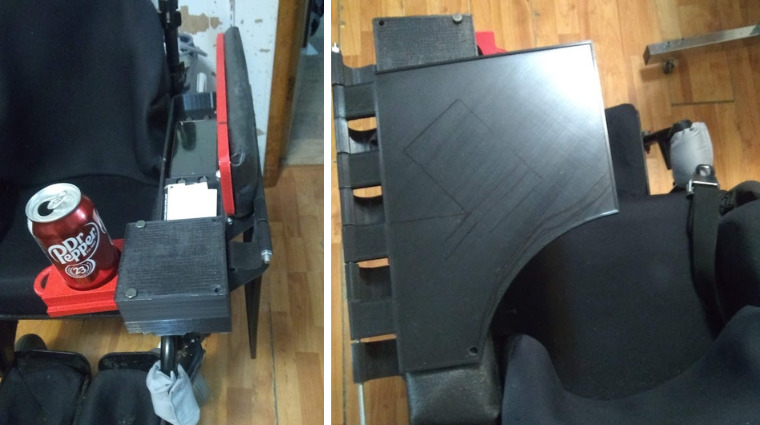
When Sheryl Deal headed to Saskatchewan Polytechnic’s Moose Jaw campus in 2018 as her daughter Megan’s medical aid, she couldn’t have known where it would lead. Expecting to remain in the background of Megan’s classes unless needed, she found herself with time on her hands and an interest in what was being taught.
“Megan uses a wheelchair and doesn’t need me all the time,” explains Deal. “She’s an independent-minded 23-year-old and really attacks life. My role while she was in class was just being there if needed. I had lots of time to listen in and think.”
Megan’s academic and career interests focus on building design and creating accessible spaces. She has taken a keen interest in computer drafting since high school, so the Architectural Technologies program was a natural fit. To make the program work with her physical limitations, Megan took additional classes to beef up her AutoCAD computer-aided design software skills through the Engineering Design and Drafting Technology program. This accommodation introduced her—and inadvertently, her mother—to the engineering design possibilities that software allows, and for Deal, a spark ignited. She got talking with Megan’s instructors and several of them, including Earl Wingert, encouraged her to explore the program.
Wingert remembers saying to her, “Hey, you’re here every day putting in the time. You should take some of these classes.” That seemingly planted a seed. Fast forward nearly two years and Deal decided to take the leap. She explains, “I’m Megan’s caregiver and that’s not stopping anytime soon. I realized I could also study alongside her. I thought, ‘We can both accomplish something here at the same time.’”
Deal enrolled in the Engineering Design and Drafting Technology program in Fall 2020 as part of the first pandemic intake. “It’s funny to say, but COVID is partly what made this possible because it gave me an opportunity to do my early coursework from home,” says Deal. “I was able to make the program fit in with my life and with Megan’s.”
Engineering Design and Drafting Technology has a co-operative education component, and Deal managed to secure remote-work placements with the City of Saskatoon—a fortunate situation that made it possible for her to participate fully in the program while supporting Megan in hers. “It hasn’t always been easy,” says Deal, “but a lot of people have gone to bat for me to make this a reality—my family included. The City of Saskatoon was also an extremely supportive co-op employer. The pandemic is partly responsible for the remote aspect being a possibility for me, and I’m grateful for that.”
COVID, of course, also made life more difficult. For Megan, being infected with the virus set her back considerably and has put her own studies on hold. “Megan had a setback, that’s for sure,” says Deal. “She’s still figuring out where to go from here and that will be her decision.”
Deal, though, has managed to plough through a full-time program and has impressed her instructors with a high grade-point average and a final capstone project that has the potential to become more than a theoretical exercise. “My project started with Megan,” explains Deal, “who asked if I could design something to help her navigate tasks more independently. Once I started using Autodesk Inventor (a design software) I had a lot of ideas,” she explains. “Drawing does not come naturally for me but by utilizing Autodesk software I could turn my ideas into a 3D design. From there I've collaborated with my son and others to create working prototypes for Megan to test.”
“It’s clear that Sheryl has an interest and aptitude for this kind of work,” says Kaya Forest, program head for Engineering Drafting and Design Technology, and “more than that, she is idea driven. She saw the possibility of what the technology could do and her mind started working.”
The prototype Deal created is an assistive device—a wheelchair add-on that allows Megan to access and organize the things she uses in her daily life. The specialized armrest tray straps on to her chair and includes cup and cell phone holders, and space to organize and access personal items such as a wallet. “This project has been remarkably rewarding because there was an instant improvement in Megan’s ability to shop independently," says Deal. “She is more comfortable ordering a drink with friends as she can use the cupholder easily. It’s bigger than what we initially envisioned. The improvement to her life has been bigger than she ever expected. We’re even seeing increased independence at home. It’s amazing.”
“To do the project justice, you have to understand that she has created a highly customized design that works for Megan’s particular needs,” says Wingert. “It’s not just any cupholder, or any phone holder. What Sheryl designed takes into consideration her daughter’s particular needs.”
Prototype two has been on Megan’s chair for a little over a month. “We’re still discovering things we need to improve or try. The design process never really ends, but I want to get it to a point where I’ve discovered the major problem areas and fix them.”
Deal is currently working on her third prototype and continues to make incremental improvements. The prototyping process began with a lot of cardboard to mock things up. “Measuring, working out dimensions and where things needed to be, not increasing the overall footprint of the wheelchair… that’s the fun part,” says Deal. “Designing on the computer is one thing but the prototype allows you to see what works.”
Wingert and Forest both note that Deal is as humble as they come, and true to character she is the first to say that she couldn’t have taken her ideas to fruition without the help of others. “I was really blessed with my capstone,” Deal says. “It doesn’t follow the typical project model but Earl was really encouraging to go for it and find a way to do it.” Turning her model into a physical product required expertise in 3D printing. Deal’s son Jason has also been attending Sask Polytech in the Innovative Manufacturing program and was able to use his skills to help her 3D print parts. “He’s been a great collaborator on this project and has been my champion from the start.”
Further collaboration with yet another program took Deal to the finish line. “Something 16 inches long is huge in the 3D world,” explains Deal, “so we had to work to get parts printed in various places.” Deal’s instructors connected her with the Computer Engineering Technology (CET) program, and they were able to use their specialized printer to create many of the parts Deal needed. “I’m on version three of my prototype,” Deal says. “I couldn’t have done this alone.”
Shaun Nanan, former CET program head and now an academic chair in the School of Information and Communications Technology (ICT), expresses his admiration for the cooperation between departments. “This collaboration resulted in developing a product that can benefit society and highlights the immense potential for interdisciplinary collaborations to drive innovation and address real-world challenges. We were so pleased to be able to work with Sheryl.”
Deal gets excited talking about the collaboration with other Sask Polytech programs and speaks of the benefits to learning from others. “It’s one of the great things about my program and instructors,” she notes. “We’re encouraged to work together to solve problems. A few fifth semester Engineering Design and Drafting Technology students assisted students in other programs design aspects of their capstone projects. These students did not have the design and drafting skill set that we have and we were happy to help them out. Everyone learned in this process.”
Forest says that Deal’s project really stood out. “It’s inspirational,” she says, “partly because there is so much passion behind it. Sheryl has worked hard to take an idea from concept to working product. The push behind it is the very real desire to improve her daughter’s life.” Deal brought Megan to her final presentation and Forest says you could feel the electricity in the room. “No one wanted her to wrap up within her allotted 10 minutes. It was evident that this was a remarkable experience these two have gone through. It was amazing to hear Megan share how the prototype changed how she operates in public.”
As capstone project presentations wrapped up, program instructors noted that this year’s graduating class included a high number of passion projects. “Several students worked long and hard on remarkable projects, says Wingert. “Sheryl is one example, but we had a real variety of projects that show the possibilities of where the program can take students. Two students worked together on designing a viable underpass and road interchange, for example. These types of projects are impressive because they are far more than an academic exercise.”
Deal’s instructors have tried to impress upon her this notion—that her project could turn out to be more than training. “I’ve been overwhelmed by the response to my capstone,” says Deal. “My instructors keep telling me ‘You need to look at patents!’” Exploring the marketability of her assistive tray is something Deal plans to do but she knows there will be more work before her product is ready for the world. “I still have materials to explore,” she explains. We’re using plastic for the prototyping, but it’s likely the final product would include multiple materials. It’s one thing to explore something on a 3D printer, but how would we mass produce it if we go that route? Or would it be a more custom product, tweaked to suit each user? There are lots of options out there and more ideas to explore.”
As Deal prepares to celebrate the end of her studies this June she’ll share convocation with her son Jason, who is also graduating from his Innovative Manufacturing program. Deal reflects, “Creating an assistive product is a far grander task than the timeline of a capstone project fully allows. Now I need to take the time to conduct further research and to create additional prototypes. As Megan continues to use prototype two, we discover more and more changes that will create a better product. In the end we want the final design to be a product that we are happy to put our names on.”
“We’re going to miss Sheryl a lot,” says Wingert. “She’s been with us for longer than just her time in the program. She is a student we won’t soon forget.” Wingert adds, “I like to think of the ripple effect that this program will have on Sheryl’s entire family. She made one simple decision to take a class, and it turned into something bigger that will make a real difference for her and her family and maybe for others.”
Forest agrees. “If we could have one wish, it would be for Sheryl and Megan to find employment together. They have such a compatible skillset and are uniquely positioned to take what they have learned out into the world alongside each other. We are rooting for them.”


Learn more about the Engineering Design and Drafting Technology program.

